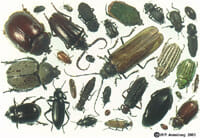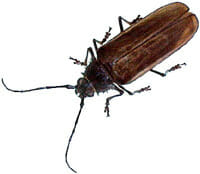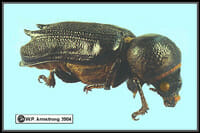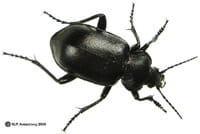Beetles – Coleoptera
 |
 |
 |
 |
Identification & Description:
There are more than 800,000 species of insects on earth, more than all the other plants and animals combined. Of this great number of insects, nearly half are beetles. Unlike other insects, beetles have a pair of leathery protective wings called elytra that cover their membranous flight wings. During flight, the elytra are spread apart and the two flight wings are unfolded and extended. Beetles come in a variety of shapes and colors, from red “ladybugs” and metallic green fig beetles to lightning beetles that glow in the dark and huge horned beetles resembling a miniature rhinoceros. Colorful beetles are used for jewelry and pins, and shiny tropical scarab beetles are strung together to make unusual necklaces. Beetles range in size from less than a millimeter (1/100 of an inch) to tropical giants over six inches long. The largest giants may weigh 40 million times more than their lilliputian relatives.
Beetles might be the most successful creatures on earth! Their incredible ability to adapt to any environment makes sure that they will exist, probably long after humans have disappeared from earth. One of the most important features of the beetles that makes them distinctly beetles is their elytra, the hard exoskeletal covering over their wings. Elytra have many functions, but the most important is protection for the beetle.
Some species are able to trap moisture on their wings and keep it because the elytra protects it from the heat and wind. This has allowed some species to travel to deserts, where moisture is scarce, because they can carry their own water with them. Other species can live under water because they are able to trap air in their wings and keep it under the elytra.
How did beetles get their names?
The order name Coleoptera is pronounced “co-le-OP-ter-a.” This name was first used by Aristotle in the fourth century B.C., more than 5,000 years ago! It comes from the Greek words “koleos,” which means sheath (or shield), and “ptera,” which means wings. The name refers to the fact that most beetles have hardened front wings, termed elytra, which cover the folded hind wings like a sheath. Insects in the order Coleoptera are commonly called beetles. The common name “beetle” comes from older English words for a “little biter”. Larvae of some species are called grubs, wireworms, and rootworms.
More about beetles:
Coleoptera is the largest order in the entire animal kingdom. There are more species of beetles than species of plants! There are about 350,000 named species of beetles in the world and many more unnamed species. In the United States and Canada, there are almost 24,000 species. That’s about 30% of all insect species in North America. The families of beetles containing the most species in North America are the rove beetles (Staphylinidae, 3100 species), the weevils (Curculionidae, 2432 species), the ground beetles (Carabidae, 1700 species), the leaf beetles (Chrysomelidae, 1474 species), the scarab beetles (Scarabaeidae, 1375 species), the darkling beetles (Tenebrionidae, 1300 species), and the long-horned beetles (Cerambycidae, 1100 species).
Habitats:
Beetles can be found in many land and fresh-water habitats. In addition to being associated with all kinds of plants, they can be found in logs or under bark, in fungi, in mud, in decaying plant and animal matter, in water, in stored food, in bird and mammal nests, and in termite nests. Species in the genus Cremastocheilas (family Scarabaeidae) live in ant nests and feed on ant larvae. Many beetles live deep in the soil or in decaying leaf litter on the ground. Other beetles live under rocks or in caves.
Mammal nest beetles (family Leptinidae) are external parasites of mammals, including beavers. These beetles live in the fur or the nests of their hosts. Some scarab beetles in the genus Trox live in bird and mammal nests, apparently feeding on the droppings of the animals or the remains of their food.
Characteristics of Beetles
Size:
Adult beetles range in size from 0.01 to almost 8 inches in body length, but antennae of some are much longer than their bodies. Beetles usually have hard bodies, but sometimes they are leathery or even have soft bodies. These bodies may be very smooth or very hairy. Most beetles are dark brown or black, but many are red, blue, green, purple or a combination of colors.
Antennae:
Beetles have many types of antennae. Some of them are threadlike, sawtoothed, comblike, feather-like, or clubbed. Some beetles have “lamellate” antennae with segments at the end of the antennae that have long, plate-like projections on one side. Weevils have “elbowed” antennae, with an elbow-shaped joint between the long first segment and remaining shorter segments.
Mouthparts:
Beetle mouthparts are usually the biting and chewing type with well-developed mandibles, or jaws being present. The mandibles may be very large and resemble the antlers of deer in males of stag beetles. Mandibles of some beetles are used in defense or mating instead of in eating. Mandibles of some predaceous (bug eating) larvae are grooved or have a tube inside for injecting digestive enzymes into the prey.
Wings:
Beetles usually have two sets of wings, the hard front wings, or elytra (elytron is singular), and the soft hind wings for flying. The hind wings are folded under the elytra when not in use. The elytra usually extend to the tip, or near the tip, of the abdomen. A special feature of Coleoptera is that the elytra meet in a straight line on the back. Some beetles, such as rove beetles, have short elytra, and most of the abdomen is exposed.
Legs:
The three pairs of legs in beetle species may be modified for swimming, digging, running, grasping, or other activities. Flea beetles (family Chrysomelidae) have hind legs modified for jumping. Males of some water beetles have wide segments for holding the female during mating. Many scarab beetles have sharp spines on their legs that are used for defense against vertebrate predators (animals with backbones).
Larvae:
Beetle larvae can be of different shapes and sizes. Some are wormlike and legless, and others are more like caterpillars, with thoracic legs and abdominal prolegs (fake legs). Wireworms, such as larvae of click beetles, have short legs and are long, hard, and wirelike. Many larvae have C-shaped bodies and are usually soft. This form of larva, which is present in scarabs and other beetles, often is called a grub. Many predaceous larvae have long legs for running along the ground.
Pupae:
Pupae are like pale, mummified versions of the adult beetle. The legs and wings project from the pupa, instead of being fused with the body as in Lepidoptera. In some species the pupa is surrounded by a silk cocoon or a round chamber made of hardened earth.
Life Cycle
Beetles have complete metamorphosis with egg, larva, pupa, and adult. Females of some beetles keep the eggs inside their bodies and give birth to live larvae. Blister beetles (family Meloidae) have a unique type of metamorphosis, termed hypermetamorphosis, in which the larva changes into different forms of larvae during its development. A blister beetle egg hatches into an active, long-legged larva. As the larva molts and becomes larger, it changes into a C-shaped larva with shorter legs. This form of larva molts into a legless instar that does not feed. Eventually, the legless instar molts into the pupa with legs and wings projecting from its body.
In some beetles, the adults help take care of the young larvae, which is a simple form of social behavior. Females of rove beetles in the genus Bledius (family Staphylinidae) build, maintain, and defend larval tunnels and also provide algae for the larvae to eat. Males and females of some Scarabaeidae cooperate in digging nests and providing their larvae with food. Bess beetles (family Passalidae) and species in other families of insects also care for their young.
Most beetle larvae pass through 3-5 instars, or stages. Some beetles may have as many as 30 instars, while one species of cave beetle is known to have only one instar. At the end of the final larval instar, the larva molts into the pupal stage. After the pupal stage, the adult beetle will emerge to feed, mate, and produce eggs for another generation. A few weevils, leaf beetles, and other beetles can reproduce without mating (parthenogenesis).
Most beetles have one generation per year, although some may have two or more in warm regions. Many scarab beetles require two to three years to complete one generation. Some long-horned beetles (family Cerambycidae) have been known to take thirty years to complete their life cycle!
Form and Feeding Habits
Most beetles are either plant feeding or predaceous ( hunters). Some species have different feeding habits in different stages, such as those with predaceous larvae and plant-feeding adults. Many species feed as scavengers on dead plants and animals. Other species feed on fungi or mold, and a few are parasitic on other insects or vertebrate animals (animals with backbones).
Among the insects, beetles are the most important group of ground-dwelling predators. Beetles will prey on both active and inactive stages, such as eggs and pupae, of a wide range of insects and other prey. However, adults of some ground beetles (family Carabidae) and many lightning beetles (family Lampyridae) prey mainly on snails. Many beetles that live in decaying leaves on the ground, or leaf litter, prey on mites (class Arachnida). Some predators can be omnivorous, with the larva or adult feeding on both plants and animals. Soldier beetles (family Cantharidae) and others have predaceous larvae and plant-feeding adults.
A unique form of predation among beetles is present with larvae of tiger beetles. Most beetles are active hunters of prey, but tiger beetle larvae, also known as “chicken chokers,” wait in burrows in the ground. These larvae have a large bump on their backs that help them hold their bodies in the burrow. When an insect walks over their camouflaged heads, they grab the prey with long mandibles.
Most kinds of plants are eaten by some kind of beetle. Many beetles have certain parts of the plant that they eat. Adults and larvae of many beetles chew off parts of leaves. Larvae of some beetles are leaf miners, eating trails inside the leaves. Other beetles bore in stems or fruit. Some kinds of beetle larvae, including white grubs and rootworms, feed on roots. Many adult beetles can be found in flowers where they may feed on the petals, nectar, or pollen. Some beetles feed on sap that flows from a tree wound.
Larvae of long-horned beetles (family Cerambycidae) and metallic wood-boring beetles (family Buprestidae) bore in the wood of shrubs and trees, especially those that are dying or dead. The female twig-girdler, a kind of long-horned beetle, lays an egg at the end of a branch on a living tree. Then, the female chews, or girdles, the stem to cut off the water supply. The tip of the branch dies and usually falls to the ground. The larva of the twig-girdler then feeds inside the dead branch. Metallic wood-borers are known also as jewel beetles.
Bark beetles (family Scolytidae) feed under the bark of trees. Some bark beetles are known as engraver beetles because when they eat they make distinctive patterns on the wood. Other bark beetles are called ambrosia beetles because they feed on a kind of fungus, known as ambrosia, that they grow in their tunnels.
Beetles in several families of Coleoptera eat many kinds of fungi. Some eat bracket fungi that grow on trees, and others prefer mushrooms or puffballs on the ground. Some beetles in fungi are actually predators that are eating larvae of beetles, flies, and other insects eating the fungi. Many beetles can be found in leaf litter that has fungi and bacteria aiding decay of the leaves. Sometimes it is not known if the beetle is eating fungi or is eating the decaying leaves and other organic materials.
Several groups of beetles feed on animal droppings, or dung. Some dung beetles (family Scarabaeidae) feed on the dung where it falls on the ground, sometimes burrowing into the ground under the dung pile. Tumblebugs are dung beetles that form a round ball of dung and roll it away to another location where it won’t be disturbed by other insects that eat the same food. Different species of dung beetles prefer different kinds of animal droppings. Some cave beetles feed on bat droppings.
Certain species in the families Scarabaeidae, Dermestidae, and Silphidae feed on decaying animal flesh, or carrion. Some carrion beetles (Silphidae) bury small animals several inches below the surface of the soil. After finding a suitable spot for burial, a mating pair of these beetles work together to move the carcass and bury it. The beetles will feed on the buried carrion and lay eggs on it as well. The developing larvae may feed on the carrion for three or four weeks. Information on an endangered species of carrion beetle can be found at the American burying beetle.
Material used from www.ivyhall.district96.k12.il.us/4th/kkhp/1insects/beetles.html